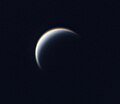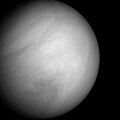 Artist's impression of Pioneer 12 in orbit above Venus | |
| Names | Pioneer Venus 1 Pioneer 12 |
|---|---|
| Mission type | Venus orbiter |
| Operator | NASA / Ames |
| COSPAR ID | 1978-051A |
| SATCAT no. | 10911 |
| Website | science.nasa.gov |
| Mission duration | Total: 14 years, 4 months and 18 days Science phase: 13 years, 10 months and 4 days |
| Spacecraft properties | |
| Bus | HS-507 |
| Manufacturer | Hughes |
| Launch mass | 582 kg (1,283 lb) [1] |
| Dry mass | 517 kg (1,140 lb) |
| Dimensions | 2.5 × 2.5 × 1.2 m (8.2 × 8.2 × 3.9 ft) |
| Power | 312 watts |
| Start of mission | |
| Launch date | May 20, 1978, 13:13:00 UTC [1] |
| Rocket | Atlas SLV-3D Centaur-D1AR (AC-50) |
| Launch site | Cape Canaveral LC-36A |
| End of mission | |
| Disposal | Decommissioned |
| Last contact | October 8, 1992, 19:22 UTC |
| Decay date | October 22, 1992 [2] |
| Orbital parameters | |
| Reference system | Cytherocentric |
| Semi-major axis | 33,405.8 km (20,757.4 mi) |
| Eccentricity | 0.842 |
| Pericytherion altitude | 181.6 km (112.8 mi) |
| Apocytherion altitude | 66,630 km (41,400 mi) |
| Inclination | 105 degrees |
| Period | 24 hours |
| Epoch | 22 November 1979, 11:53:20 UTC [3] |
| Venus orbiter | |
| Orbital insertion | December 4, 1978 |
The Pioneer Venus Orbiter, also known as Pioneer Venus 1 or Pioneer 12, was a mission to Venus conducted by NASA as part of the Pioneer Venus project. Launched in May 1978 atop an Atlas-Centaur rocket, the spacecraft was inserted into an elliptical orbit around Venus on December 4, 1978. It returned data from Venus until October 1992. [2] [4]
Contents
- Spacecraft
- Instruments
- Experiments
- Table
- Mission
- Launch and arrival at Venus
- Observation of Venus
- Observation of comets
- See also
- References
- Bibliography
- External links
The spacecraft conducted radar altimetry observations allowing the first global topographic map of the Venusian surface to be constructed.






















